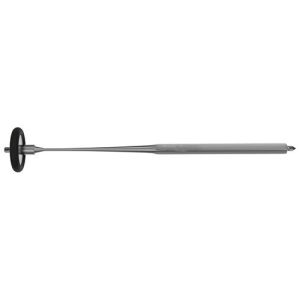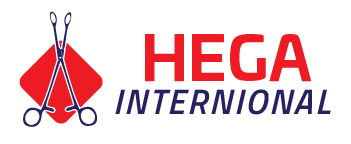Showing 49–64 of 1909 results
-

Babcock Intestinal Forceps
Read moreJaws w/ atraumatic parallel serrations
Babcock Intestinal Forceps have jaws with atraumatic parallel serrations that are intended to hold a shorter section of intestine with minimal trauma and constriction. There is a ratchet on the inner side of the ring-handles so that the forceps can lock in place when needed during a surgical procedure. The forceps are polished to a dull, satin finish to minimize glare below operating room lights.
-

Babcock Tissue Forceps
Read moreBabcock Tissue Forceps
standard pattern.
Babcock Tissue Forceps come in a standard pattern with semicircular rounded tips to allow for holding or grasping delicate body structures. These forceps are crafted from premium German operating-room grade stainless steel and are available in a wide variety of lengths.
-

Babcock Tissue Forceps – Tungsten Carbide
Read moreTungsten carbide jaws
Babcock Tissue Forceps have jaws that are made from tungsten carbide, the hardest metal made for surgical instruments. Precision-milled serrations are formed onto the tungsten carbide inserts, resulting in pyramid-shaped teeth that provide a non-slip grip. Pyramid-shaped teeth align perfectly with each other to provide a durable and reliable grasp of the most delicate or toughest tissues, as well as needles, sutures, dressing materials and delicate vessels. Smooth tungsten carbide inserts are also available for delicate procedures. Spring tension allows for surgeons to maintain proper and consistent position, ensuring optimal grip without having to apply excess force. These forceps also feature gold-plated handles.
-

Babcock-Baby Tissue Forceps
Read moreBabcock-Baby Tissue Forceps
extra-delicate jaws.
Babcock-Baby Tissue Forceps contain extra-delicate jaws that can be used to grasp delicate tissues or structures like the ovaries. The forceps generally have smaller jaw width and shorter overall length than the standard pattern. The shorter length may provide better control or ability to work closer to the body.
-

Babinski Percussion Hammer
Read moreBabinski Percussion Hammer
9″ (23.0 cm)
Babinski Percussion Hammer is ideally used in diagnostic evaluation of reflex responses. This uniquely designed hammer has a crown shaped head that is rimmed with rubber to allow greater comfort. This instrument features an elongated neck that flares for added grip and tapers back into a fine point for use as a aesthesiometer to test tactile reflexes.
-

Backhaus (Ball & Socket) Towel Clamp
Read moreBackhaus (Ball & Socket) Towel Clamp
5-1/8″ (13.0 cm
Backhaus (Ball and Socket) Towel Clamp has the primary use of securing drapes to the surgical site to prevent any changes in their position during an operation. The ball and socket on the tips of the inwardly curved jaws help to secure the drapes while minimizing the penetration and damage. To use this clamp, it is positioned to the desired place and then closed using the ring-handles. The ratchet allows this instrument to stay secure until it is released.
-

Backhaus Towel Clamp
Read moreBackhaus Towel Clamp
Backhaus Towel Clamp is mainly used to fasten drapes or towels to patients during medical procedures in order for them to stay on. The pointed tips of the jaws cave inward so that they enter both the skin and drape. This clamp is designed with ring-handles and ratchet fixation to allow the clamp to remain in place until it is released.
-

Bacon Cranial Rongeur
Read moreCranial Rongeur is a unique instrument crafted for use in neurosurgical procedures that require access to the brain tissue or other areas associated with it. This instrument can be used to chip away or create a window in the skull to create increased access so the surgical field. These rongeurs feature a 2.0 mm jaw width and are set at a slight angle that allows the handles to remain comfortable out of the surgical field and able to manipulate easily.
-

Bailey Gigli Saw Guide
Read more13″ (33.0 cm) Gigli Saw Guide is an instrument specifically designed for use alongside a Gigli saw which is preferred in amputation procedures. The Gigli saw is flexible and thus needs a guide to keep it aligned to the area where the incision and cutting is taking place. This instrument is ideally used in amputation procedures in which a smooth and consistent cutting motion is required. Additionally this guide is 13″ long.
-

Bainbridge Artery & Intestinal Forceps
Read moreBainbridge Artery & Intestinal Forceps
standard pattern.
Bainbridge Artery and Intestinal Forceps come in a standard pattern and may be used in medical procedures such as when a bowel needs to be clamped. These forceps have long, slightly tapered jaws with longitudinal serrations that are presented in a curved or straight pattern in different overall lengths.
-

Balfour Abdominal Retractor W/ Fixed Side Blades
Read morew/ ratchet bar mechanism, w/ fixed fenestrated side blades, 7-1/8″ (18.1 cm) maximum spread
Balfour Abdominal Retractor with Fixed Side Blades contains a ratchet bar mechanism and side blades that are fenestrated. These side blades are designed to push apart an incision while the ratchet holds the instrument in position. The solid center blade, however, can be lowered or raised to provide better visibility for the surgeon.
-

Balfour Abdominal Retractor W/ Fixed Side Blades – 4″ Deep
Read morew/ fixed fenestrated side blades, 4″ deep & center blade #2470-73 (3-3/8″ x 2-1/2″)
Balfour Abdominal Retractor with Fixed Side Blades contains fenestrated side blades that are fixed onto the instrument. This retractor is primarily used during surgeries in which large abdominal incisions need to be held open to provide more visibility to the surgeon. Moreover, the instrument is offered in different sized spreads to accommodate different patients.
-

Balfour Extra-Deep Center Blades
Read moreFor balfour retractor systems w/ fixed side blades, 2-3/4″ wide x 4″ deep
Balfour Extra-Deep Center Blades consists of a 4″ deep blade that is curved at a right-angle. This blade may be intended for larger patients or for accessing deeper areas of the abdominal cavity so that they can be held in place. Another feature of this center blade is that it contains loop holes in the center slot so that it can provide different spreads.
-

Balfour Fourth Blade Attachment
Read moreBalfour Fourth Blade Attachment
for detachable balfour retractor systems
Balfour Fourth Blade Attachment is especially designed to be used as an addition to the Detachable Balfour Retractor Systems. The long, flat blade can accommodate to different spread sizes to fit the needs of the procedure being conducted. It also contains an option for the right arm or left arm depending on the area of the abdominal wall that needs to be retracted.
-

Balfour Narrow Center Blade
Read moreBalfour Narrow Center Blade
for detachable balfour retractor systems
Balfour Narrow Center Blade consists of a flat blade on one end that is curved at a right angle. This blade also contains small lips on the edges to keep a large incision open. The handle of this instrument is fenestrated and has small loops that rods from lateral blades can fit onto in order to create the desired spread size.
-

Balfour Standard Center Blade – For Detachable System
Read moreDetachable System
for detachable balfour retractor systems
Balfour Standard Center Blade is designed to be used with the detachable Balfour Retractor Systems. This blade is offered in two different sizes and contains a curved blade with lips on the outer edge to keep an incision open. The handle of this center blade is fenestrated in the middle and includes placement holes so that it can spread to different sizes.
